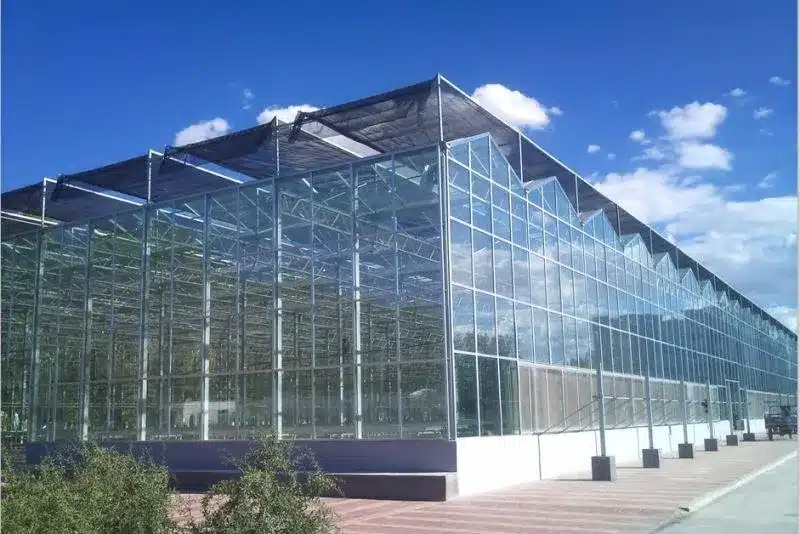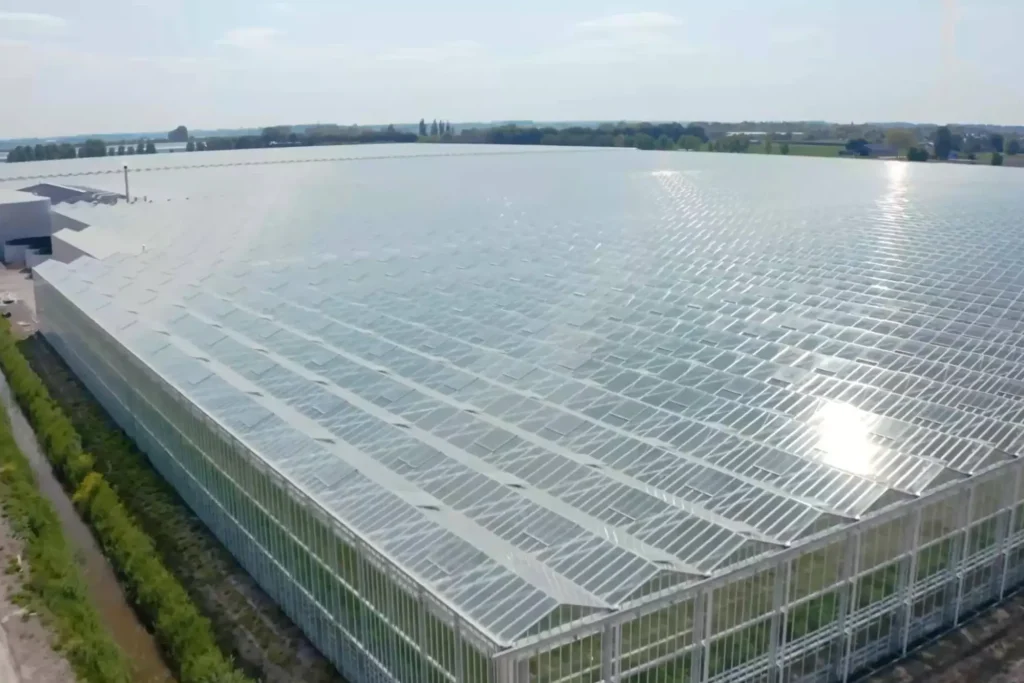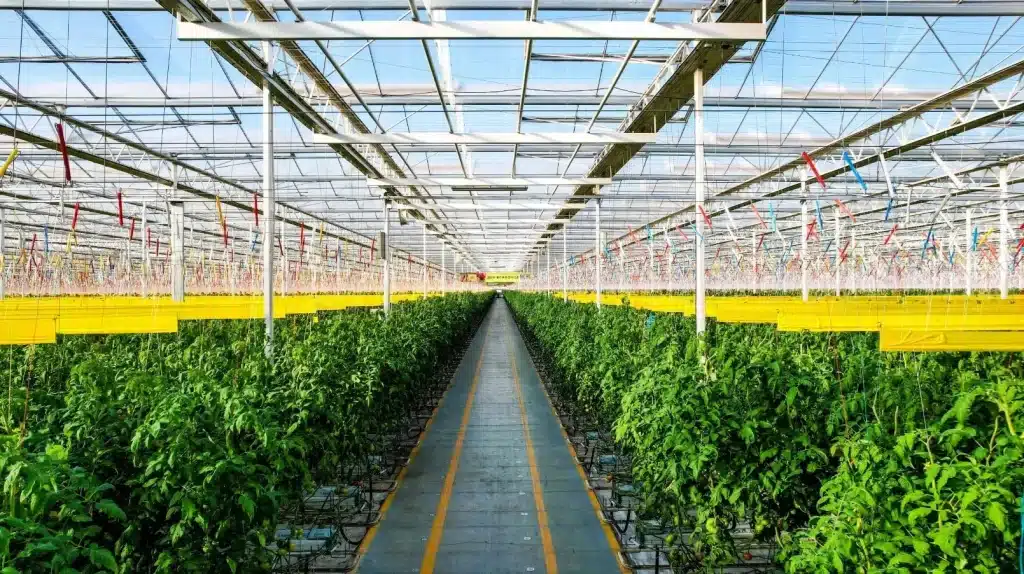Commercial glass greenhouses are a special type of greenhouse. They use glass as their main material to let light in. These greenhouses last longer than others and work well in different places and weather conditions.
Don’t Miss: What is the Best Greenhouse Covering?
These greenhouses are important in modern farming because they save energy and help the environment. Thanks to new technology, they are getting smarter every day. This means they can grow many vegetables, fruits, and flowers yearly. This helps farmers make more money and keeps our food supply steady.

Thinking about building a glass greenhouse? There are 12 important things to consider first. This article will guide you through these steps to help you plan better.
What to Consider Before Building a Commercial Glass Greenhouse
1. Choosing the Perfect Location
Finding the right spot for your greenhouse is crucial. You want a place with abundant sunlight, flat land, and stable soil. These conditions help plants grow well. Make sure the groundwater isn’t too high to prevent flooding or mudslides. Also, having enough water and power is essential for production and everyday needs. If you can use geothermal energy or leftover industrial heat, that’s a bonus because it provides extra warmth for your greenhouse. Good drainage is another must-have for excess water, especially during heavy rains.
If the spot you pick isn’t flat, you might need to level the land. Avoid places near tall buildings or big trees that block the sun. If there’s no other option, ensure there’s enough open space around your greenhouse so your plants still get the sunlight they need. Finally, choose a location that’s easy to reach. This simplifies getting supplies in and taking care of daily maintenance.
This rewrite simplifies the language and structures the information into more manageable pieces for young readers, focusing on clarity and directness.

2. Picking the Best Orientation
The best way to set up your greenhouse is in a north-south orientation. This layout helps make sure that every part of the greenhouse gets plenty of sunlight. It allows all crops to soak up the warm rays, no matter where they are inside.

If you can’t set up your greenhouse north-south due to the land or other issues, aim for an area that gets sunlight from morning to noon. Morning sunlight is great for growing plants. The most important thing is to ensure that all your crops get enough light.
3. Setting the Right Height
The height of a greenhouse is usually measured by its gutter height, which is how high the structure is from the ground to its highest point. Making your greenhouse taller is good for the plants and makes it easier for people working inside.
A taller greenhouse means more air can circulate inside, which helps control the environment and makes automated systems run smoothly. It also allows for different planting methods, like hanging baskets or ground planting. The top of the greenhouse should be 2 to 3 meters above the tallest plants to ensure enough airflow and protect plants from getting too hot.

If you’re using tools like picking carts, ensure that there is enough room for them to operate. This way, your greenhouse is attractive but also practical and helpful for both the plants and the people taking care of them.
4. Streamlining Transportation Routes
When designing a greenhouse, consider it a full system where everything connects smoothly. From the moment the crops are harvested, they should move effortlessly to the sorting line, then to the packaging area, and finally get safely stored in the warehouse. This flow makes the process efficient and well-organized.

5. Choosing the Right Frame Material
When picking materials for your greenhouse frame, think about three things: how long the structure will last, its resistance to rust and corrosion, and how much light your plants need. Choose a white powder-coated frame if your crops need a lot of light. It not only looks clean and appealing but also reflects more light, which boosts light efficiency. This coating absorbs less heat, keeping the frame cooler in summer—up to one-third cooler than standard steel frames.

6. Selecting the Best Climate Curtains
The type of climate curtains you choose should match your plants’ light needs. For a high-efficiency greenhouse, go for shade cloths that reflect light well. This will help your plants get the sunlight they need to thrive.

7. Implementing Natural Ventilation
Natural ventilation is a key and cost-effective way to cool your greenhouse. Ensure the design includes enough vent areas to meet your maximum ventilation needs. Since wind directions change, include windows that can open both leeward and windward. Windward windows help with cooling and reducing humidity. Open leeward windows for mild cooling. To cut costs, use both types of windows in summer to enhance natural airflow.

8. Reducing Shading Areas
It’s important to design your greenhouse to minimize shaded areas to boost light efficiency and cut costs. How do you reduce shading? It involves optimizing how trusses are installed and choosing the right curtain system. Trusses play a key role in supporting the greenhouse’s covering materials. For instance, Dutch greenhouses cover large areas and have trusses installed only along the gutter direction. In contrast, most Chinese greenhouses have trusses installed along both the gutter and the bay. The gutter is the low area between the greenhouse roofs, and the bay is the span or width. In the U.S., truss installation is flexible, tailored to meet specific design goals, adapt to climate conditions, and incorporate technological advances.

The curtain system should be carefully adjusted for light, insulation, or shading. A cable-driven curtain system is often recommended because, although it requires precise installation, it reduces shading area and is cost-effective compared to traditional gear and rack systems.

9. Climate Curtains Installation Methods
Installing climate curtains can greatly improve your greenhouse’s environment, affecting temperature distribution and air circulation. There are two main methods:
Triangular Installation Method: In large greenhouses with uneven temperature distribution, using a combination of inner insulation cloths and triangular shade cloths can be effective. This setup divides a large space into smaller areas, each covered by a triangular shade cloth. This helps maintain consistent climate conditions in each area, reduces temperature variability, and supports better plant growth.
Opposing Side Installation Method: When climate curtains are fully extended, they can block airflow. To avoid this, install shading and insulation cloths on opposing sides. This setup allows air to flow even when the curtains are extended, improving the greenhouse climate. Ensure the curtains are spaced closely when retracted to minimize shading and reduce light loss without blocking airflow.
In summary, the triangular method helps manage temperature more evenly in large spaces, while the opposing side method reduces shade areas and maintains air circulation. Both strategies are designed to save energy and optimize conditions for plant growth in your greenhouse.
10. Strategic Heating Pipe Placement
When cultivating tomatoes, the position of heating pipes can greatly influence the ripening of fruits and the timing of the harvest. Strategically placing these pipes allows you to create the best growing conditions for your tomatoes.

- Positioning Near the First Cluster of Fruits: Positioning heating pipes near the bottom of the plant, particularly close to the first cluster of fruits, can speed up the ripening process at this specific spot. This approach helps fruits change color faster, shortening the harvesting time. This is especially useful for tomato varieties that take longer to mature, allowing for earlier harvesting and quicker market access.
- Positioning in the Middle (Near the Third or Fourth Cluster of Fruits): Placing heating pipes around the middle of the plant, near the third or fourth cluster of fruits, can encourage the fruits to grow larger. However, this might compromise the plant’s nutritional balance, as the roots may not supply enough nutrients for all fruits. This could potentially shorten the harvesting period. To counter this, many greenhouses adopt a dual-layer heating pipe system. This setup speeds up ripening for lower fruits with bottom pipes, while pipes in the middle help increase fruit size, aiming to balance nutrient distribution and ripening.
Communicating with Horticulture Technicians
Designing an effective greenhouse heating system involves close communication with horticulture technicians to understand the specific needs of the plants being grown. Knowing the varieties, their growth cycles, and ripening rates, you can accurately determine the best positions for heating pipes, maximizing yield and quality.
11. Balancing Temperature and Humidity
Think of using a misting fan on a hot day – it feels much cooler, right? Similarly, modern smart greenhouses use advanced high-pressure misting systems to help cool down plants. This system sprays water into very fine droplets that evaporate quickly, cooling the air and significantly reducing the greenhouse temperature by up to 5°C in unshaded greenhouses and 7°C in shaded ones.

The fine mist doesn’t leave residue on leaves, minimizing the risk of bacterial growth. For plants that need less humidity, installing an overhead sprinkler system can reduce temperatures by an additional 1 to 2 degrees Celsius, providing essential cooling without excessive moisture.
12. Installing a Side Roll-Up System
Consider installing a side roll-up system to cut down on light pollution and improve conditions inside your greenhouse. This system has three main benefits:

- Blocking Heat in Summer: During the hot summer months, this system prevents outside heat from warming up the greenhouse. It keeps the internal temperature cooler, making it a better environment for the plants to grow.
- Retaining Heat in Winter: In the colder winter months, it helps keep the warmth inside the greenhouse. This saves on heating costs and ensures your plants continue growing in a cozy environment.
- Controlling Nighttime Light: The lights inside the greenhouse can disturb nearby residents at night by causing light pollution. The side roll-up system can effectively block out these lights, reducing or eliminating light pollution.
In summary, a side roll-up system is a versatile tool that manages the greenhouse’s climate and keeps light pollution in check. It’s an essential technology for modern greenhouse farming.
Conclusion
In building an efficient, energy-saving, and environmentally friendly commercial glass greenhouse, it is essential to consider several key factors. These twelve technical aspects form the basic framework for constructing a modern commercial glass greenhouse, which not only ensures the health and high yield of plants but also enhances the economic efficiency of the greenhouse. Through careful planning and technological integration, it is possible to establish a smart and efficient commercial glass greenhouse, effectively aiding in generating high economic returns from your commercial glass greenhouse investment.





